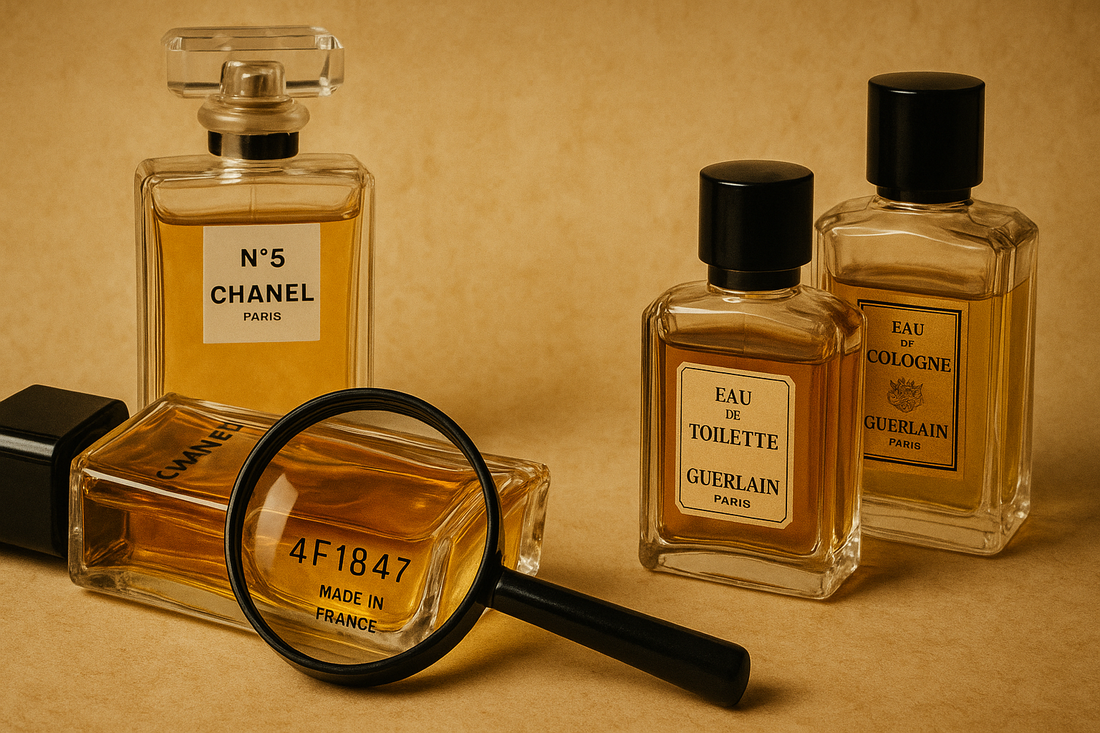
🔍 The Ultimate Guide to Vintage Perfume Batch Codes: How to Find the Year of Production
Share
⏱️ Reading time: about 7 minutes
In the world of perfumery, especially for those who collect vintage or discontinued fragrances, knowing a perfume's production date is crucial. It's more than just a curiosity: the year of production can reveal a lot about the quality of the fragrance, the type of formulation (pre- or post-reformulation), its aging, and even its market value.
This is why batch codes exist: often cryptic codes, printed on the bottom of the bottle or packaging, which represent the true identity card of a perfume.
In this definitive guide, we'll explain what they are, how to read them, the differences between the various brands, and how to best use them to help you distinguish authentic vintage items, reformulations, and potential fakes.
📚 Table of Contents
- 🧾 What are batch codes?
- 🕵️♂️ Why is the batch code important?
- 🕰️ How batch codes have evolved over time
- 🏷️ Practical examples for fashion houses
- 🚫 Beware of fakes
- 🛠️ Coming soon to ScentX
🧾 What are batch codes?
The batch code (also called lot code) is an alphanumeric code printed or engraved on the bottom of the perfume bottle or outer carton. It is used by manufacturers to track the production batch and can indicate the year, month, or even the day of production.
Each brand uses its own coding system, which may vary over time. Some batch codes are easy to interpret, while others require the help of decoding tables or dedicated websites.
🕵️♂️ Why is the batch code important?
- ✅ Check the authenticity of the perfume (fakes often lack it or have inconsistent codes).
- 📅 Trace the exact production date , useful for collectors or for comparing different versions of the same juice.
- 🔬 Understand if the perfume is pre-reformulation , that is, if it was produced before a change to the formula (often caused by IFRA restrictions).
- 🧪 Evaluate the aging of the juice , to understand any changes in the olfactory profile.
🕰️ How batch codes have evolved over time
Batch codes weren't always a tool designed for consumers. Initially, they were used solely for internal production purposes: logistics, inventory management, and batch recalls in the event of problems. With the growth of the secondary perfume market (especially vintage and collectibles), these codes have taken on a new value, becoming a reference tool for identifying authenticity and dating.
Some fashion houses—such as Chanel , Dior , and Yves Saint Laurent —have modified the structure of their codes over time, moving from simple formats to more complex patterns. This makes it necessary to know not only the code, but also the year a particular pattern was used by that fashion house.
📖 Read also : Reformulated perfumes: how to recognize them and what really changes
Here's how their use has evolved over the decades:
| Period | Main features | Main function |
|---|---|---|
| 1970s–1980s | Many bottles had no visible codes. Batch codes were either printed internally or absent. | Industrial tracking; not intended for the public. |
| 1990s | Beginning of the systematic adoption of visible codes, often simple alphanumeric ones. | Production and logistics management. |
| 2000s | Consumer attention is growing. Collecting is starting: many brands are making codes more accessible and recurring. | Batch identification, batch comparison. |
| After 2010 | Widespread use of online tools (such as CheckFresh) for batch reading. Longer and more complex codes. | Traceability, authentication, anti-counterfeiting defense. |
| Today | Some brands (e.g. Givenchy, Mugler, Paco Rabanne) are experimenting with QR codes, NFC and blockchain. | Real-time verification, fight against counterfeits, and protect intellectual property. |
🏷️ Practical examples for fashion houses
-
Dior: Example:
3W01→ "3" = year 2013, "W" = November, "01" = day. - Chanel: Until the 2000s: simple numeric codes. Today: 4-5 digit format readable via batch database.
-
Guerlain: Non-standardized pre-2000 codes. Post-2000: e.g.,
1A01. -
Creed: Codes like
20J01, with year, month and day.
We're preparing detailed articles for each maison: stay tuned!
🚫 Beware of fakes
An inauthentic batch code is often a warning sign. But be careful: skilled counterfeiters copy real codes perfectly , making it more difficult to distinguish a fake from an original.
In our next article we will explore this sensitive topic in detail:
🔜 Coming soon to ScentX: Fake perfumes in shops – how to recognize them, avoid them, and protect yourself
🛠️ Coming soon to ScentX
We are developing an interactive batch code decoding tool , which will allow you to enter a perfume code and get the production date and details.
⚠️ The tool is still in the experimental phase and we cannot guarantee a launch date.
🔗 Related articles
- Reformulated Perfumes: How to Recognize Them and What's Really Different
- How to recognize an altered perfume
Need help interpreting a batch code? Email us at info@scentx.it , we'll be happy to answer!
